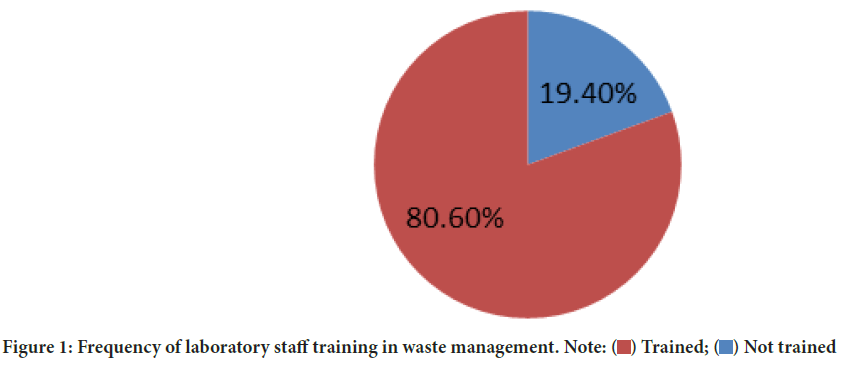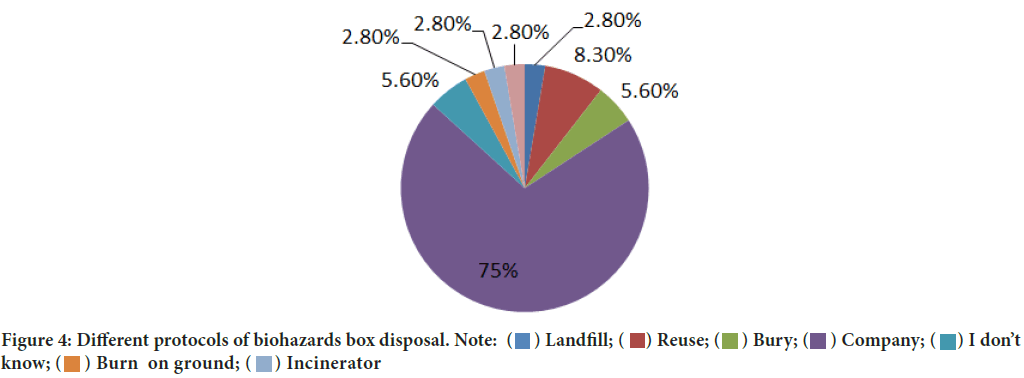Short Communication - (2022) Volume 13, Issue 9
Abstract
A good environmental health conditions is a challenge worldwide. However, Majority of Laboratory wastes extremely dangerous to the environment, animals, and human because of increasing numbers of laboratories and health facilities especially on big cities in Africa like Khartoum state Capital of Sudan. A cross-sectional study was carried out on a group included 36 laboratories in Khartoum state from February to march 2021. There is no unique protocol for waste management and disposal followed by laboratories in Khartoum state so jeopardize laboratorian and community.
Keywords
Waste, Management, Laboratory, Health facilities
About the Study
Medical laboratories are the main producer of the infectious waste, including microbiological materials, infectious sharps, and blood specimens and other types of samples. However, an improper management of the contaminated waste could leads to diseases transmission (Askarian M, et al., 2012). The best strategy for managing a laboratory waste aims to maximize safety and minimize environmental impact, and considers these objectives from the time of purchase (National Research Council, 2011). However, whether the laboratories in Khartoum are following standard waste management protocol or and their staff have sufficient training in the waste management, the environmental impact of lab waste is hot question to answer in this study. The aim of this study was to assess the waste management procedures used at clinical laboratories in Khartoum, Sudan and assessment of laboratory staff training.
A cross-sectional study was carried out on group included 36 laboratories (hospital, clinic, and health center laboratories) in Khartoum state capital of Sudan from February to march 2021, laboratories from outside Khartoum state were excluded. Approvals have been taken from each laboratory and participants’ voluntary informed consent and the data were collected using administered questionnaire from random samples under COVID-19 regulations and the data was analyzed by SPSS version (22) and presented as frequencies.
Majority of medical laboratories in Khartoum state have sharps and needles waste, biological waste of human samples mainly (urine, stool, blood) and regular waste. Followed by chemical waste, culture media respectively, and radioactive waste which is the least frequent waste which is presented in Table 1. More than two thirds of laboratory staff did not get training and workshops in waste management as shown in Figure 1. Greater portion of laboratories have specialized company approved by authorities to collect the medical waste and treat it. Similar percentage of laboratories has dustman for this job and in few laboratories the collection and treatment of the waste done by laboratory staff which is illustrated in Figure 2.
| Frequency | Number | Waste types |
|---|---|---|
| 91.70% | 33 | Needles and sharps |
| 94.40% | 34 | Biological(patients samples) |
| 22.20% | 8 | Bacteria culture media |
| 33.30% | 12 | Chemicals |
| 8.30% | 3 | Radioactive |
| 91.70% | 33 | House |
Table 1: Frequencies of laboratory waste in medical laboratories in Khartoum state

Figure 1: Frequency of laboratory staff training in waste management. Note:  Not trained
Not trained

Figure 2: Waste management responsibility. Note:  Dust man
Dust man
Majority of laboratories staff is separating the medical sharps from other types of wastes in safety boxes and get rid of it by specialized company in medical waste. Few laboratories throw the safety box in landfill and reuse the safety box again and others burring or burning it as shown in Figure 3 and 4. Majority of laboratory staff they don’t know how to manage chemical waste as presented in Table 2. Regarding chemical and biological waste there is variation in disposal methods as shown in Tables 3 and 4.
| Waste | Frequency of staff don’t know laboratory waste disposal protocols |
|---|---|
| Chemicals | 55.60% |
| Biological | 19.40% |
| Culture media | 8.30% |
| Radioactive | 11.10% |
Table 2: Laboratory waste disposal protocols awareness among laboratory staff
| Protocol | Frequency |
|---|---|
| Sewage | 27.80% |
| Pour it in street | 2.80% |
| Pour it far away from buildings | 5.60% |
| Pour it in a well | 8.30% |
Table 3: Disposal of chemical waste protocols followed by laboratory staff
| Protocol | Frequency |
|---|---|
| Medical waste company protocol | 8.40% |
| Ordinary waste company | 55.60% |
| Landfill | 2.8% |
| Burn | 13.9% |
Table 4: Disposal of biological waste protocols followed by laboratory staff
Figure 3: Laboratory waste separation in medical laboratories. Note:  Not separating
Not separating
Figure 4: Different protocols of biohazards box disposal. Note:  Bury;
Bury;  know;
know;  Incinerator
Incinerator
The results showed there is no unique protocol followed in Khartoum state clinical labs for laboratory waste management especially infectious waste as well as inadequate training for laboratories staff. Neglecting guideline of lab waste management and disposal jeopardize lab staff, dustman, and others life with infectious diseases. These results were supported by many published studies.
Saad SA found in his study that most of waste, office, general, food, construction debris, and hazardous chemical materials were all mixed together as they are produced in hospitals, collected, and finally disposed out. A small part of infectious, and sharps waste in some health facilities are gathered separately and handled in a central incinerator. In Khartoum state no guideline for hospital waste, or even hazardous waste only some general environmental guideline. At the hospital level, no policies or rules were existed, except in the radiotherapy center, where they treat radioactive wastes by the laws of the Sudanese Atomic Agency. Urgent actions are required for the treatment and prevention of hazards related with this type of waste (Saad SA, 2013).
Hassan AA, et al. found that Sharps management is inefficient in Khartoum hospitals. As all wastes are gathered without separation and disposed improperly, especially needles (Hassan AA, et al., 2018).
Mukhtar CM found that waste management guidelines, waste collection program, radioactive waste container and hazards chemical waste management are not available in National Public Health Laboratory (Mukhtar CM, 2016).
Elnour AM, et al.reported that the nursing and sanitation staff at the main hospitals of the White Nile State in Sudan recorded significant improvement in their knowledge and practice with regard to hospital waste management immediately after the educational intervention program and three months later (Elnour AM, et al., 2015).
Conclusion
Laboratories wastes are harmful to the environment, human, and animals because it contains infectious material, sharp materials, chemical reagents, and radioactive reagents. Laboratories staff have inadequate training in waste management and disposable. There is no unique protocol for waste management and disposal followed by laboratories in Khartoum state so jeopardize laboratorian and community. Thus laboratories should give their staff training in waste management and disposable and get rid of their waste only through specialized medical waste company. Government should develop our national waste management and disposable guideline based on the international guideline and implement it with follow up in order to have clean environment from laboratories waste in Sudan.
Declarations
Ethical approval
Collection of data was approved by of Khartoum State Ministry of Health Research Department ethical committee.
Informed consent
Informed consent was obtained from all individual participants included in the study.
Ethical guidelines
All procedures performed in studies involving human participants were in accordance with the ethical standards of Khartoum State Ministry of Health Research Department ethical committee and with the 1964 Helsinki declaration and its later amendments or comparable ethical standards.
Acknowledgment
I acknowledge all laboratories that participated in this study.
References
- Askarian M, Motazedian N, Palenik CJ. Clinical laboratory waste management in Shiraz, Iran. Waste Manag Res. 2012; 30(6): 631-634.
[Crossref] [Google Scholar] [Pubmed]
- National Research Council. Prudent practices in the laboratory: Handling and management of chemical hazards. National Research Council. 2011.
[Crossref] [Google Scholar] [Pubmed]
- Saad SA. Management of hospitals solid waste in Khartoum State. Environ Monit Assess. 2013; 185(10): 8567-8582.
[Crossref] [Google Scholar] [Pubmed]
- Hassan AA, Tudor T, Vaccari M. Healthcare waste management: A case study from Sudan. Environments. 2018; 5(8): 89.
- Mukhtar CM. Assessment of facilities and safety in National Public Health Laboratory. Sudan University of Science and Technology. 2016.
- Elnour AM, Moussa MM, El-Borgy MD, Fadelella NE, Mahmoud AH. Impacts of health education on knowledge and practice of hospital staff with regard to Healthcare waste management at White Nile State main hospitals, Sudan. Int J Health Sci (Qassim). 2015; 9(3): 315.
[Google Scholar] [Pubmed]
Author Info
Hussein Abker Hussein*Citation: Hussein HA: Assessment of Laboratory Waste Management and Laboratory Staff Awareness in Khartoum State
Received: 01-Jun-2022 Accepted: 23-Jun-2022 Published: 30-Jun-2022, DOI: 10.31858/0975-8453.13.9.606-609
Copyright: This is an open access article distributed under the terms of the Creative Commons Attribution License, which permits unrestricted use, distribution, and reproduction in any medium, provided the original work is properly cited.
ARTICLE TOOLS
- Dental Development between Assisted Reproductive Therapy (Art) and Natural Conceived Children: A Comparative Pilot Study Norzaiti Mohd Kenali, Naimah Hasanah Mohd Fathil, Norbasyirah Bohari, Ahmad Faisal Ismail, Roszaman Ramli SRP. 2020; 11(1): 01-06 » doi: 10.5530/srp.2020.1.01
- Psychometric properties of the World Health Organization Quality of life instrument, short form: Validity in the Vietnamese healthcare context Trung Quang Vo*, Bao Tran Thuy Tran, Ngan Thuy Nguyen, Tram ThiHuyen Nguyen, Thuy Phan Chung Tran SRP. 2020; 11(1): 14-22 » doi: 10.5530/srp.2019.1.3
- A Review of Pharmacoeconomics: the key to “Healthcare for All” Hasamnis AA, Patil SS, Shaik Imam, Narendiran K SRP. 2019; 10(1): s40-s42 » doi: 10.5530/srp.2019.1s.21
- Deuterium Depleted Water as an Adjuvant in Treatment of Cancer Anton Syroeshkin, Olga Levitskaya, Elena Uspenskaya, Tatiana Pleteneva, Daria Romaykina, Daria Ermakova SRP. 2019; 10(1): 112-117 » doi: 10.5530/srp.2019.1.19
- Dental Development between Assisted Reproductive Therapy (Art) and Natural Conceived Children: A Comparative Pilot Study Norzaiti Mohd Kenali, Naimah Hasanah Mohd Fathil, Norbasyirah Bohari, Ahmad Faisal Ismail, Roszaman Ramli SRP. 2020; 11(1): 01-06 » doi: 10.5530/srp.2020.1.01
- Manilkara zapota (L.) Royen Fruit Peel: A Phytochemical and Pharmacological Review Karle Pravin P, Dhawale Shashikant C SRP. 2019; 10(1): 11-14 » doi: 0.5530/srp.2019.1.2
- Pharmacognostic and Phytopharmacological Overview on Bombax ceiba Pankaj Haribhau Chaudhary, Mukund Ganeshrao Tawar SRP. 2019; 10(1): 20-25 » doi: 10.5530/srp.2019.1.4
- A Review of Pharmacoeconomics: the key to “Healthcare for All” Hasamnis AA, Patil SS, Shaik Imam, Narendiran K SRP. 2019; 10(1): s40-s42 » doi: 10.5530/srp.2019.1s.21
- A Prospective Review on Phyto-Pharmacological Aspects of Andrographis paniculata Govindraj Akilandeswari, Arumugam Vijaya Anand, Palanisamy Sampathkumar, Puthamohan Vinayaga Moorthi, Basavaraju Preethi SRP. 2019; 10(1): 15-19 » doi: 10.5530/srp.2019.1.3








